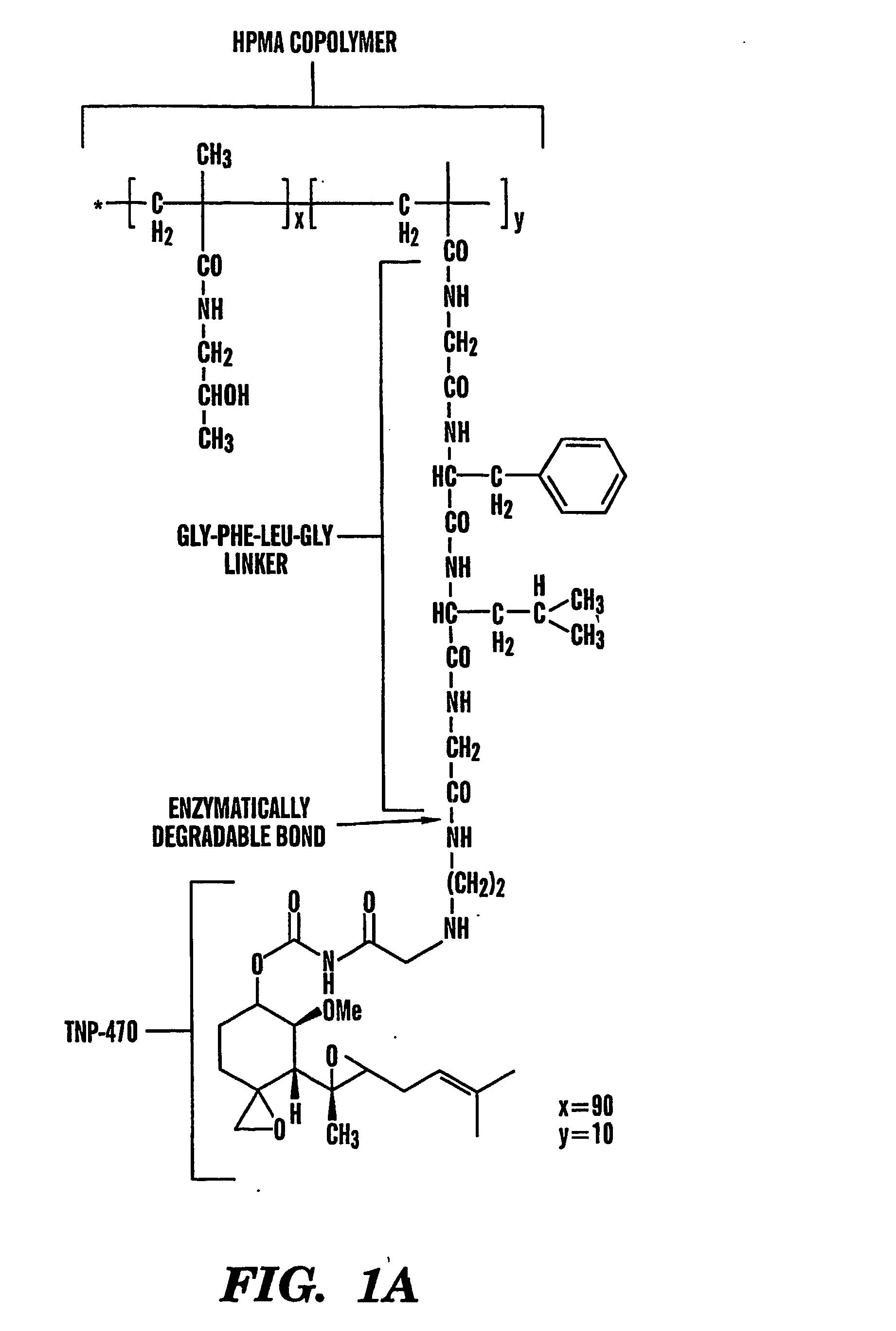Tnp-470 polymer conjugates and use thereof
a polymer conjugate and polymer technology, applied in the field of tnp-470 polymer conjugates, can solve the problems of unsatisfactory efforts to limit the toxicity of tnp-470, the optimal means of using these agents alone or in combination with drug delivery systems, and the inability to fully explain the effect of tnp-470 neurotoxicity, etc., to achieve the effect of lowering the neurotoxicity of tnp-470
- Summary
- Abstract
- Description
- Claims
- Application Information
AI Technical Summary
Benefits of technology
Problems solved by technology
Method used
Image
Examples
example 1
Methods
Materials
[0038] A random copolymer of HPMA copolymerized with methacryloyl-Gly-Phe-Leu-Gly-p-nitrophenyl ester (HPMA copolymer-MA-GFLG-ONp) incorporating approximately 10 mol % of the MA-GFLG-ONp monomer units was prepared as previously reported24 and provided by Polymer Laboratories (UK). The polymeric precursor was used for ethylenediamine (en) incorporation and the product HPMA copolymer-GFLG-en had a Mw of 31,600 Da and polydispersity (PD) of 1.66. TNP-470 was kindly provided by Douglas Figg from the NCI (USA). 2-Propanol, methanol, orthophosphoric acid and chloroform were from Sigma (all HPLC grade). Dimethylformamide (DMF) and dimethylsulfoxide (DMSO) were from Aldrich (ISA). All other chemicals were of analytical grade from Aldrich (USA) and Fisher Chemicals (USA) unless otherwise stated. Vivacell 70 ml (10 kDa MW cut-off PES) was from VivaScience (USA). Isoflurane was purchased from Baxter Healthcare Corporation (USA). Matrigel basement membrane matrix (from Engel...
example 2
Miles Assay:
[0060] One of the problems with angiogenesis-dependent diseases is increased vessel permeability (due to high levels of VPF) which results in edema and loss of proteins. A decrease in vessel permeability is beneficial in those diseases. We have found, using the Miles assay (Claffey et al., Cancer Res., 56: 172-181 (1996)), that free and bound TNP-470 block permeability. Briefly, a dye, Evans Blue, was injected i.v. to anesthesized mice. After 10 minutes, human recombinant VEGF165 was injected intradermally into the back skin. Leakage of protein-bound dye was detected as blue spots on the underside of the back skin surrounding the injection site. After 20 minutes, mice were euthanized. Then, the skin was excised, left in formamide for 5 days to be extracted and the solution read at 620 nm. Putative angiogenesis inhibitors such as free and conjugated TNP-470 were injected daily 3 days prior to the VEGF challenge. The same was repeated on tumor-bearing mice to evaluate th...
PUM
| Property | Measurement | Unit |
|---|---|---|
| molecular weight | aaaaa | aaaaa |
| molecular weight | aaaaa | aaaaa |
| molecular weight | aaaaa | aaaaa |
Abstract
Description
Claims
Application Information
 Login to View More
Login to View More - R&D
- Intellectual Property
- Life Sciences
- Materials
- Tech Scout
- Unparalleled Data Quality
- Higher Quality Content
- 60% Fewer Hallucinations
Browse by: Latest US Patents, China's latest patents, Technical Efficacy Thesaurus, Application Domain, Technology Topic, Popular Technical Reports.
© 2025 PatSnap. All rights reserved.Legal|Privacy policy|Modern Slavery Act Transparency Statement|Sitemap|About US| Contact US: help@patsnap.com



